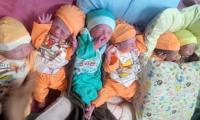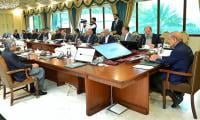Pakistan’s vibrant art scene is creating colourful ripples in the New York landscape. Last month a Pakistani art exhibition that documented three generations of Pakistani painting was held at the UN complex.
This month Pakistan’s leading artist Rashid Rana came to Museum of Modern Art (MOMA) to share his ideas as artistic director of the first Lahore Biennale to be held in 2017. And then came Salima Hashmi, a critical force behind Pakistan’s current art movement – as a teacher, a painter and an art critic. She was at the Asia Society as part of the Lahore Literature Festival (LLF) to discuss Pakistan’s contemporary art.
Salima Hashmi’s latest book, ‘The Eye Still Seeks’ documents the last 20 years of Pakistani painting. Ambassador Maleeha Lodhi, Pakistan’s permanent representative to the UN, and her brilliant team came up with the idea to bring the LLF to New Yorkers through the Asia Society – an effective way to project the country’s soft power abroad.
In his talk with MOMA Director Glenn Mowry, Rashid Rana was open to experiments in the Lahore Biennale. One would not expect less from Rashid. The biennale will take place throughout the city – Lahore – and will not be restricted to a certain area. It will also open to art tourism. Rashid will soon seek ideas from across the world. Responding to some apprehensions about the location and limitations of the city, Rashid successfully argued the potential Lahore offered for a biennale and the freedom, real and perceived, enjoyed and managed intelligently by many generations of Pakistani artists.
As the idea of biennale moves from Europe to the East, it offers immense potential for contribution by Lahore to international art movement. Rashid was accompanied by Qudsia Rahim of the Lahore Biennale Foundation (LBF), who started this initiative and is bringing utilitarian and visually pleasing art through different projects in the city.
Salima’s panel in the LLF included two young artists Salman Toor and Sadia Shirazi. The panel, moderated by Amin Jaffer, had an interesting underplay of generational shifts in views on arts and how information technology has facilitated permeation of art and ideas and has overcome the physical constraints. The powerful visuals from Salima’s book played on the screen in the background documented the rich diversity of work.
The discussion, however, did not touch upon the remarkable work done in landscape or portrait painting in Pakistan. Reference to works and influence of masters like Saeed Akhtar and Khalid Iqbal or contemporary landscape work by Nazir Ahmad could have further enriched the debate.
The two sessions on Pakistani English and Urdu literature that should be considered the highlights of the day, given the name of the forum, reflected on the need for the LLF concept to be loyal to Brand Lahore and delve deeper into the rich literary heritage of the city it aspires to represent both while organising the event at home or taking the ensemble overseas. The session on Urdu literature was starkly missing the literary depth and breadth of Lahore.
Some good work has been produced by Pakistani authors writing in English but how this generation has or has not been affected by vernacular literature is a theme that needs to be explored. Pakistani English language writers like Mohammed Hanif and Nadeem Aslam (of ‘Maps for lost Lovers’ fame) have imbibed Urdu literature whereas some have barely traversed through it. Conversations on Pakistani literature remained incomplete without debating the work of giants like Abdullah Hussein, Intizar Hussein and Mustansar Hussain Tarar who enjoy deep linkages with the city of Lahore both because of their work and having lived there.
Another interesting session on the culture of Lahore gave a most engaging conversation with the famous film/TV director and actos Sarmad Khoosat, who through his anecdotal narration brought the audience much closer to the spirit of Lahore than any other speaker. His several generations of linkage to the city was evident from the way he nuanced how the traditional kite – the ‘guddi’ – is different from the ‘patang’. Other sessions addressed education in Pakistan, Pakistan-US relations and the future of Pakistan.
The LLF in New York provided a valuable expose of different dimensions of Pakistan, many of which remain in the dark because of the selected focus of the Western media. It brought all this to the foreign audience and to the spirited Pakistani diaspora for whom the LLF came as an occasion to visit home in New York. Rashid Rana has expressed the commitment to be more inclusive of Lahore’s richness.
One hopes that the LBF will be able to meet the shortcomings of the LLF and the two major events from Lahore will bring to the world the city that remained for centuries the socio-cultural hub of the Subcontinent and a melting pot for different cultures. And we hope to see more from Pakistani arts and literature in New York and the world beyond.
Email: smt2104@caa.columbia.edu
A woman walks past a building of the International Monetary Fund. — AFP/FileThe annual and spring meetings of the...
Late Benazir Bhutto's daughter Asifa Bhutto Zardari addresses the Christian community in Bihar Colony on January 23,...
Representational image. — PexelsWater is an important scarce natural resource that is required for several everyday...
Pakistani employees of online marketplace company Kaymu at work in Karachi. — AFP/FileThe true spirit of development...
India uses Afghanistan as a backstage area to carry out terrorist attacks against Pakistan
Another report by the Pakistan Institute of Peace Studies states that 78 per cent of attacks have been carried out by...







